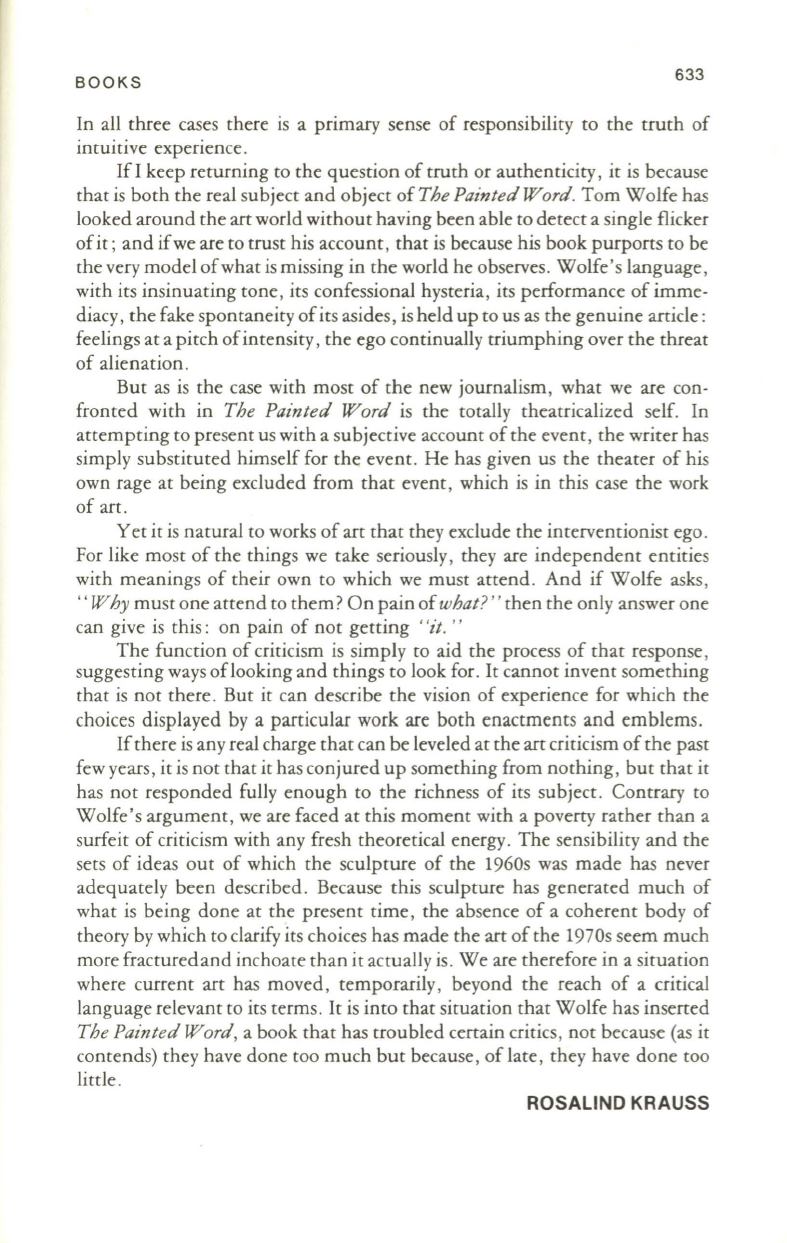
BOOKS
633
In all three cases there is a primary sense of responsibility to the truth of
intuitive experience.
If I keep returning to the question of truth or authenticity, it is because
that is both the real subject and object of
The Painted Word.
Tom Wolfe has
looked around the
art
world without having been able to detect a single flicker
of it; and ifwe are to trust his account, that is because his book purports to be
the very model ofwhat is missing in the world he observes. Wolfe's language,
with its insinuating tone , its confessional hysteria, its performance of imme–
diacy, the fake spontaneity of its asides, is held up to us as the genuine article :
feelings at a pitch of intensity, the ego continually triumphing over the threat
of alienation .
But as is the case with most of the new journalism, what we are con–
fronted with in
The Painted Word
is the totally theatricalized self. In
attempting to present us with a subjective account of the event, the writer has
simply substituted himself for the event. He has given us the theater of his
own rage at being excluded from that event, which is in this case the work
of art .
Yet it is natural to works of art that they exclude the interventionist ego .
For like most of the things we take seriously , they are independent entities
with meanings of their own to which we must attend. And if Wolfe asks,
" Why
must one attend to them? On pain of
what?"
then the only answer one
can give is this: on pain of not getting
" it.
"
The function of criticism is simply to aid the process of that response,
suggesting ways of looking and things to look for.
It
cannot invent something
that is not there . But it can describe the vision of experience for which the
choices displayed by a particular work are both enactments and emblems.
If there is any real charge that can be leveled at the art criticism of the past
few years, it is not that it has conjured up something from nothing , but that it
has not responded fully enough to the richness of its subject . Contrary to
Wolfe's argument, we are faced at this moment with a poverty rather than a
surfeit of criticism with any fresh theoretical energy. The sensibility and the
sets of ideas out of which the sculpture of the 1960s was made has never
adequately been described. Because this sculpture has generated much of
what is being done at the present time, the absence of a coherent body of
theory by which to clarify its choices has made the
art
of the
19705
seem much
more fractured and inchoate than it actually is. We are therefore in a siruation
where current art has moved, temporarily, beyond the reach of a critical
language relevant to its terms. It is into that situation that Wolfe has inserted
The Painted Word,
a book that has troubled certain critics, not because (as it
contends) they have done too much but because, of late, they have done too
little .
ROSALIND KRAUSS


